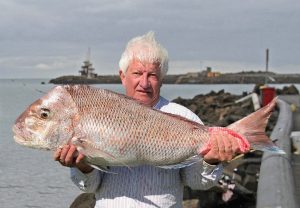
Ross Boxhaul with the 7.5 kg snapper he caught from the Lee Breakwater on Sunday morning (Picture: Bob McPherson).
Although stormy weather kept most anglers ashore over the weekend, those who managed to get out earlier in the week, included Justin Burns, wife Katryna and son Jai, who fished for whiting off St Leonards.
At first, there wasn’t much doing with banjo sharks and other unwanted species taking their strips of squid, but toward evening, it was a different story.
In a short window of opportunity as the sun went down, they caught a dozen good size fish before they went off the bite.
The Burns crew also fished the Sheepwash on the Barwon estuary, hopeful of catching a mulloway as others have done of late, but they found elephant fish, not mulloway on the bite as did others.
Unfortunately, anglers are only allowed to keep, or possess, one elephant fish: So, who – for goodness sakes – concocts these stupid restrictions?
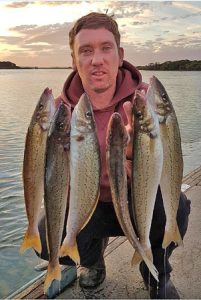
Justin Burns with a sample of his whiting catch off St Leonards (Picture: Katryna Burns).
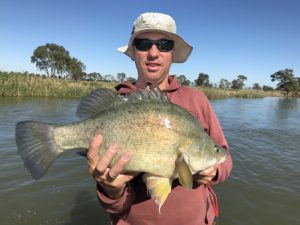
Justin Burns with one of the golden perch he caught at Cohuna on the Murray the previous weekend (Picture: Katryna Burns).
Offshore
Early last week, Chris Stamalos took a run out from Barwon Heads, anchoring up in 25 metres of water off the old Black Rocks outfall: A good move as it turned out for he caught a 13.5 kg gummy shark right away.
Things settled down after that, but then a maelstrom of white water erupted behind his boat, followed by the scream of his reel. As it turned out he’d hooked a 9 kg gummy shark on one hook and a 1.5 kg salmon on the other, something that more or less solved the white water mystery.
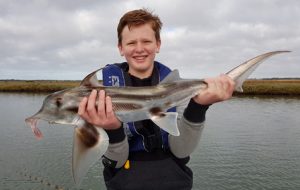
Jai Burns with an elephant fish from the Barwon estuary (Picture: Justin Burns).

Hugo Milkunda with the cuttlefish he caught, and later released (Picture: Rod Ludlow).
Corio Bay Bellarine Peninsula
Mike Windsor Clifton Springs Boat Hire reports that squid have been the main chance with bag limit catches by no means rare, but bottom fishing out deep has been a rather disappointing with the number of small flathead.
Whiting are about though said Mike, and among those to catch them were Mark Sanders and his two sons who returned with twenty that they caught between the boat ramp and The Dell. However, he said that leatherjackets have been a nuisance on the softer baits used for whiting.
With the ominous threat of an approaching storm late Friday afternoon, Andrew Johnson and Dennis O’Brien braved the gathering northerly and hit the suds off Clifton Springs where they caught six squid.
From then on, they anchored up in 4.5 metres of water inshore from the nearby mussel farm toward evening, and – despite the contrary conditions – they caught a number of whiting with their better fish hitting the 40 cm mark.
Rod Ludlow of Beachlea Boat Hire at Indented Head reports that flathead are still about with some really good size specimens coming from the shallows. However, squid are still the main catch, said Rod along with a number of cuttlefish, one of which he sent in a photo of, along with its captor, Hugo Milkunda, who released it from the beach.
Freshwater
John Clements of the Lake Purrumbete Holiday Park reports that with stormy weather over the weekend, virtually nobody was fishing. However, earlier in the week, redfin enthusiasts, including Angus Robinson from Altona, took a swag of fish from 600 to 800 grams using minnow for bait.
Lake Bullen Merri was also a challenge, except perhaps for Wayne Black of Camperdown who has taken chinook salmon to 2.5 kg from the bank on several occasions lately, casting out with pilchard fillets for bait.
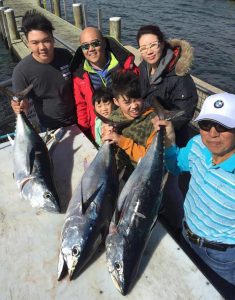
Clients of Bagout Charters with a sample of the tuna they caught on Sunday morning in 50 metres of water, east of the Portland Harbour (Picture: Bob McPherson.
Portland
Bob McPherson of Portland reports that the aftermath to stormy weather usually provides an opportunity to catch large snapper from the Lee Breakwater, and that was the case over the weekend, where Ross Boxhaul caught a beauty of 7.5 kg on Sunday morning.
And, with an improvement in the weather, clients of Bagout Fishing Charters went in search of tuna on Sunday, and of which they caught several in 50 metres of water some 14 kilometres east of the Portland Harbour.
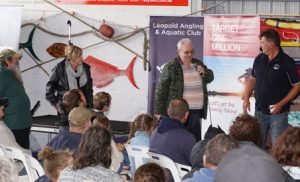
Celebration day: On Sunday the public were invited to an event at the Leopold Angling and Aquatic Club celebrating the closing of the greater part of Corio Bay to commercial netting: From left to right: Mickey Veitch of the Rod and Gun Association, Lisa Neville, Member for Bellarine and Minister for Police, Geoff Wilson with microphone, Ivan Bereza, Commodore of the Leopold Angling Club and past president of Friends of Corio Bay Action Group (Picture: Neil Slater).
Peter asks:
There are tiny garfish everywhere in the Grammar School Lagoon at the moment: Do you know when they spawn, and how fast they grow?
Peter; on reading an article by Ross Winstanley, based on a 2008 stock assessment conducted by the Marine and Freshwater Research Institute at Queenscliff, I offer the following:
Garfish spawn in the warmer months from October to March when females school up in the shallows, attaching multiple batches of perhaps 750 relatively large eggs to the seagrass and algae.
Garfish grow rapidly, averaging 17cm after one year and 27cm after three years with sexual maturity being reached at 18 months. Females are larger than males and have been recorded at 50 cm and possibly ten years of age. However, two year old fish dominate local catches.
